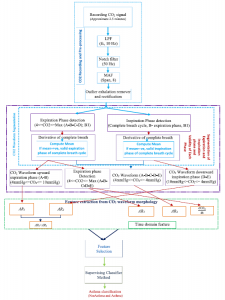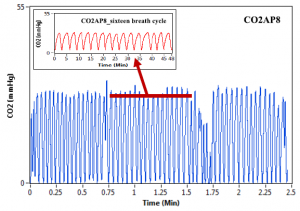

Currently, carbon dioxide (CO2) waveforms measured by capnography are used to estimate respiratory rate and end-tidal CO2 (EtCO2) in the clinic. However, the shape of the CO2 signal carries significant diagnostic information about the asthmatic condition. Previous studies have shown a strong correlation between various features that quantitatively characterise the shape of CO2 signal and are used to discriminate asthma from non-asthma using pulmonary function tests, but no reliable progress was made, and no translation into clinical practice has been achieved. Therefore, this paper reports a relatively simple signal processing algorithm for automatic differentiation of asthma and non-asthma. CO2 signals were recorded from 30 non-asthmatic and 43 asthmatic patients. Each breath cycle was decomposed into subcycles, and features were computationally extracted. Thereafter, feature selection was performed using the area (Az) under the receiver operating characteristics curve analysis. A classification was performed via a leave-one out cross-validation procedure by employing a support vector machine. Our results show maximum screening capabilities for upward expiration (AR1), downward inspiration (AR2), and the sum of AR1 and AR2, with an Az of 0.892, 0.803, and 0.793, respectively. The proposed method obtained an average accuracy of 94.52%, sensitivity of 97.67%, and specicity of 90% for discrimination of asthma and non-asthma. The proposed method allows for automatic classification of asthma and non-asthma condition by analysing the shape of the CO2 waveform. The developed method may possibly be incorporated in real-time for assessment and management of the asthmatic conditions.
The paper is due to appear in IEEE Access journal.
